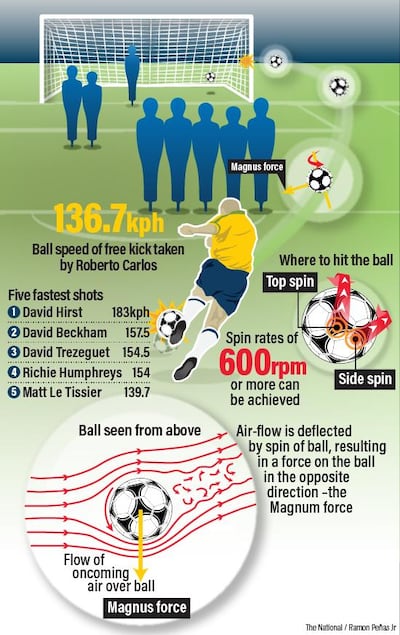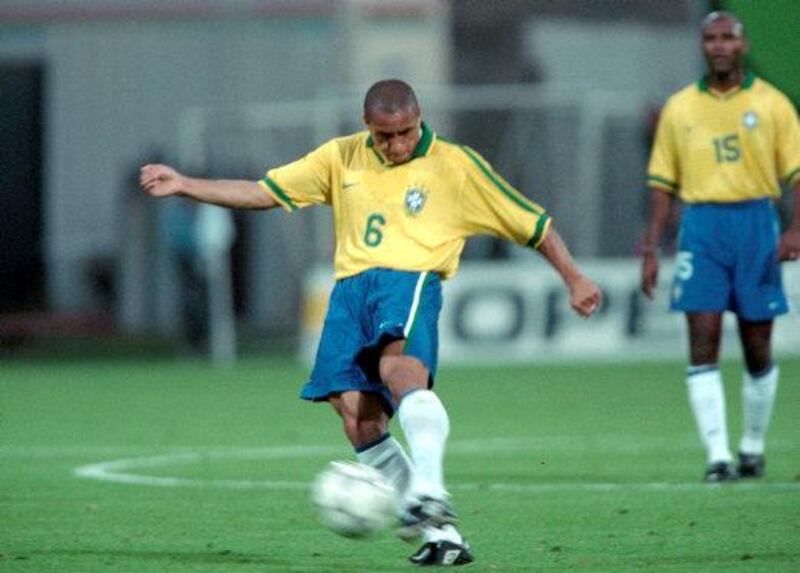It appears seemingly out of nowhere, and leaves people wide-eyed with amazement. Long dismissed as a myth, over recent weeks it has been witnessed around the world and it could decide the outcome of today’s World Cup Final or the Wimbledon tennis championship.
Scientists call it the Magnus effect: the ability of spinning objects to create gravity-defying forces. Yet while its existence is no longer disputed, arguments still rage over exactly how to explain it.
Top sport stars, on the other hand, have only one concern: how to conjure up its powers on demand.
Some have clearly got close to mastering it. During the group stages of the World Cup, Portugal’s Cristiano Ronaldo made headlines with his stunning use of the Magnus effect to complete his hat-trick against Spain.
At first, his free kick looked far off-target, the ball seemingly headed wide of the wall of defenders. But then the force took over and magically curled the ball around the back of the wall and into the goal.
French football fans will no doubt be hoping defender Benjamin Pavard will today repeat the incredible Magnus Effect goal he scored earlier in the World Cup against Argentina. In what was arguably the shot of the tournament, he controlled a tricky cross, then struck the ball so that it first headed away from the goalkeeper, then simultaneously curled and dipped into the net.

Cynics might say Pavard was simply lucky. Yet the way he positioned his body and struck the ball suggests he knew exactly how to increase his chances of success.
The trick lies in getting the right mix of three forces: the pull of gravity, the Magnus Effect and aerodynamic drag.
The action of gravity is most familiar to us — and therefor most likely to let us down if other forces interfere with it. And that is exactly what the Magnus Effect does.
Named after German physicist Heinrich Gustav Magnus, who first investigated it in the mid-19th century, it appears whenever air flows around a spinning object, such as a football that has been kicked off-centre.
As the ball travels, its spin affects the flow of air over the nooks and crannies of its panelled surface accelerating the air travelling in the direction of the spin, and slowing it down on the opposite side.
How this makes the ball swerve has, however, long been the source of argument.
Many textbooks still claim that the change in speed causes a pressure difference across the ball, changing its direction. The argument is that the air is obeying a bit of school science called Bernoulli’s Law. This states that making fluids travel faster reduces their pressure. As the air flowing across the ball travels at different speeds, it must therefore also create a pressure difference on opposite sides of the ball, and make it swerve.
But — like so much in aerodynamics, including explaining how planes fly — the reality is more subtle.
Air is both compressible and slightly “sticky”, properties that Bernoulli’s Law struggles with. The correct explanation is actually simpler. The air travelling over the ball in the direction of the spin speeds up and changes direction. In other words, it accelerates. Then by Newton’s famous law of action and reaction, this generates a force on the ball, making it swerve.
This then leads to a simple rule: if you want the ball to curl left, then kick it to the right of centre, and vice versa.
But as Pavard’s shot showed, the Magnus effect can also make a ball dip. This requires kicking the ball slightly above-centre. That gives it top-spin, making it drop faster than gravity alone would manage. A kick below-centre gives the ball back-spin, making it travel further and flatter.
_______________
Read more:
How viruses like Nipah evolve to become more deadly
[ Scientists hope to unveil first-ever image of a black hole with the Event Horizon Telescope ]
[ Stephen Hawking: A man of mind-boggling achievements and defiance ]
______________
Put like that, it sounds simple. But because the spin-rate is so important, the ball must be kicked in just the right spot. Missing by just a centimetre can send a shot from the edge of the penalty box wide of its target by a metre or more.
And on top of all this, there’s a third force to deal with: aerodynamic drag. Roughly speaking, the faster the ball, the higher the drag. But as the ball slows below around 30 km/hr, the flow of air over its surface changes, increasing the drag with sometimes dramatic effect.
The wonder is that any football player can achieve the right mix of all three forces with any reliability. Yet there’s every chance we will witness a demonstration in Moscow later today.
Tennis fans are much more likely to see the wonders of spin in today’s final at Wimbledon. That’s partly because tennis balls are aerodynamically less complex than footballs with their panelled surfaces.
But another reason is that it’s easier to control the spin-rate with a racket than a boot.
Even amateur tennis players can learn how to “slice” the ball, running their racket upward against it to produce topspin, or downward for back-spin.
The Magnus effect then does the rest. Top-spin produces a force that makes the ball drop unexpectedly fast; back-spin makes it travel further and flatter.
As a bonus, both also affect what happens when the ball hits the opponent’s racket or the ground.
Professional tennis players can summon up the Magnus Effect to order. But the top stars can also control its strength with exquisite precision.
The likes of Rafa Nadal, Kevin Anderson or Novak Djokovic can make the ball spin at over 3,500 revolutions a minute — faster than a washing-machine spin cycle.
That means the ball completes around 80 rotations when it reaches an opponent on the baseline and bends the law of gravity.
For the two teams in Moscow and the two players at Wimbledon, success or defeat could depend on their ability to wield the Magnus effect.
So whoever you support, as they prepare for the start you may want to say quietly: “may the Force be with you”.
Robert Matthews is Visiting Professor of Science at Aston University, Birmingham, UK






